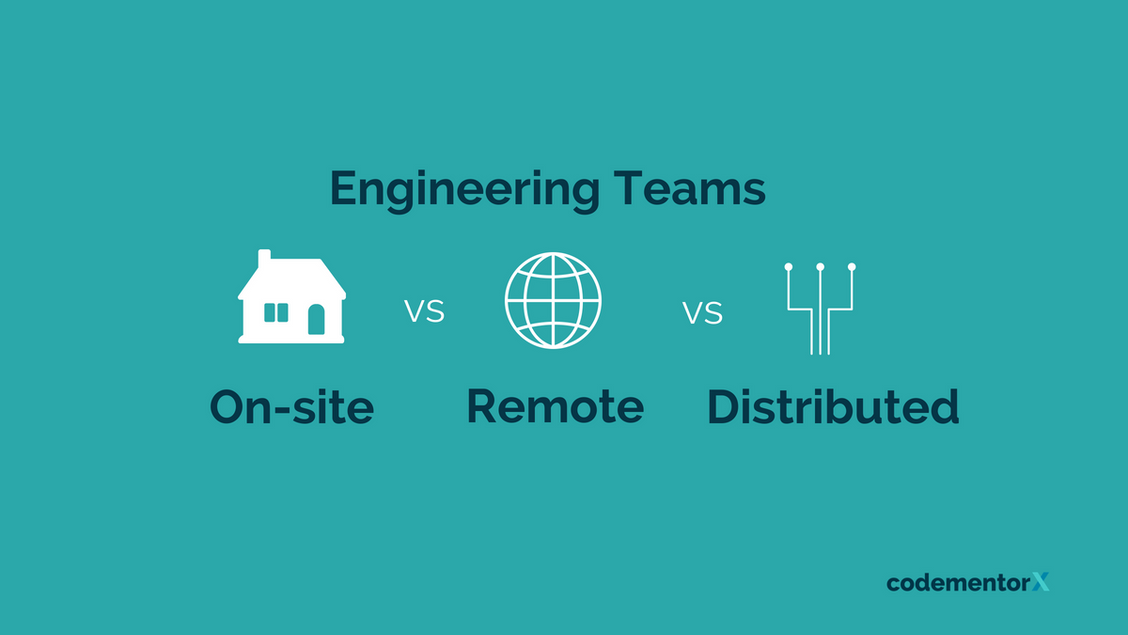You’re an engineering manager of a growing medium-sized company. You’re sitting at your desk and looking at your team, which is slowly outgrowing its allotted office space. You’re pretty sure you’re going to have to downsize desks or move to a bigger space to accommodate your team’s new size.
What if, however, you didn’t have to look for a new office or get smaller desks? What if your office could embrace remote work or even, gasp, become a distributed team? What are the benefits and drawbacks to each of these options?
We’re going to look at the how different types of engineering teams (on-site, distributed, and remote) stack up in terms of culture, communication, hiring, and flexibility.
We’ll compare on-site teams to distributed teams to see what the major differences are between them and how to cope with the challenges of each model. We’ll then examine the major difference between remote and distributed teams and how to deal with one major challenge remote teams face.
By the end of this post, you’ll know whether or not the grass really is greener on the other side.
Looking to hire the best remote talent? See how Arc can help you:
⚡️ Find the world’s top developers, designers, and marketers
⚡️ Hire 4x faster with fully vetted candidates
⚡️ Save up to 58% with global hires
Hire top talent with Arc risk-free →
On-Site Team vs Distributed Teams
Just to make sure we’re on the same page, we will be using the following definitions:
- On-site team: has a physical office space where all members of the team work from.
- Distributed team: has no physical headquarters where team members work from. Every team member works from his or her home, a café, or a coworking space of their choice.
Examples of on-site teams: Bank of America, Aetna, IBM, Yahoo, and Best Buy
Examples of distributed teams: Zapier, Buffer, Hotjar, Automattic, and InVision
Building a Strong Culture
On-site Teams
On-site teams, for the most part, have an advantage when it comes to cultivating a strong culture (although many distributed companies are giving them a run for their money). For one, it’s easier to plan meetups, team dinners, and bonding activities when everyone is in the same place. Whether it’s the same uniform, the same time zone, or the same air they’re breathing, on-site teams have an easier time creating a strong culture.
Distributed Team
While many big-name distributed companies use Slack (or other chatting applications) and have annual retreats to make up for team members not being in the same space, for people used to working on-site, working for distributed companies can feel lonely at times.
Though underrated, office cooler interactions contribute to company culture, team bonding, and can improve mood and productivity, which motivates distributed companies to try to make up for this gap as much as possible through electronic means.
How to Cope
On-site teams might suffer from culture issues if their corporate office (or startup founder) doesn’t prioritize culture. If your company isn’t invested in fomenting a strong culture, as an engineering manager, you can take it upon yourself to create one by planning dinners, after-work drinks, or weekend activities with your own team.
Big players in the distributed team realm have tried alleviating culture problems with annual retreats (all expenses paid), office cooler Slack channels, common strong values, or virtual events and team chats. While annual retreats are certainly easier to plan if your company has money to spare, Slack channels, Google Hangouts, and other virtual team bonding events are possible even with a limited budget.
Read More: Freelance Web Developer vs Dev Agency: Which is Best for My Project?
Improving Communication
On-site Team
Communication is another area where on-site teams have an advantage. Need to talk to a coworker? Walk a few cubicles down. Disaster strikes? Emergency team meeting in 20 minutes. With an on-site team, you can discuss ideas together in front of a whiteboard, brainstorm for a new feature, or simply chat about your current project without having to wait for time zones to match.
Distributed Team
With distributed teams, communication can be an issue, especially if employees are literally spread around the world. Technologically speaking, while we have whiteboards, screen sharing, and other ways around communication difficulties, unless there’s a clear policy on working asynchronously, distributed teams might experience more delays in responses and feedback compared to on-site teams.
How to Cope
As an on-site team, if what you’re doing is working, then you do you. If you need to catch up as an engineering team more often, consider holding daily scrums, weekly stand-up meetings, or just chatting informally as a team.
As a distributed team, invest in communication software, such as Slack, Zoom, Google Hangouts, etc., to help your team communicate as quickly and as efficiently as possible.
One other possibility is adjusting your mindset to working asynchronously. Consider making it official policy to empower team members to act rather than being on standby for another coworker’s responses, which could make things run more smoothly and prevent bottlenecks.
Read More: 10+ Senior Software Engineer Interview Questions to Ask Your Candidates
How to Hire Talent
On-site Team
As an engineering manager of an on-site team, if you’re located in a tech hub, major city, or a town that people want to move to, you’re probably doing better than most people.
While your candidate pool is limited to the people who want to relocate to your city, or who are already living there, it’s not a death knell for hiring new talent if your location is trendy or desirable. However, if you’re living in a smaller town, it might be harder (but not impossible) to convince top talent to move to your city just to work for you.
Distributed Team
One benefit of a distributed engineering team is that you’re not limited by geographical location when it comes to hiring. If your organization doesn’t have rules stipulating employee citizenship or immigration status, the world is literally your oyster when it comes to hiring.
According to Eilon Reshef, co-founder and CTO of Gong.io, “Instead of taking the mediocre candidate in your area, you can hire the superstar who lives on the other side of the country. Limiting yourself to hiring within your locality restricts you to a small talent pool. You may be forced to settle for mediocre talent simply because you need the position filled. Companies that hire remote workers have a larger pool of top-notch talent.”
How to Cope
If you’re living in a smaller town and need talent quickly to complete a project, consider hiring freelance developers to help you achieve your next deliverable if you’re short-handed. Hiring a freelance developer can be a cost-effective and reliable solution to your need for talent if the local candidate pool isn’t fulfilling your needs.
If you’re an engineering manager for a distributed team, you have less of a supply problem. If you’re having trouble onboarding hires, this article on how to onboard developers should help you bring your new distributed hire up to speed.
Read More: Go Beyond the Whiteboard & Coding Skills to Find Talented Developers
With Great Flexibility Comes Great Responsibility
On-site Team
One potential downside to being an on-site team is a lack of flexibility when it comes to employee retention. You’ve probably experienced this if you’ve had a stellar employee who everyone loved resigning because their family obligations necessitated a move. Unless your company allows some remote work, it’s not uncommon to have to say goodbye to team members who can’t stay local.
Distributed Team
Imagine waking up out of bed, going through your morning routine, and being able to work without having to fight your way through traffic. According to studies, long commutes are big hits on health and productivity.
Being able to work without fighting traffic means your patience levels are higher, your mood is better, and you generally feel more ready to work because it doesn’t feel like half a day has passed already. That’s one benefit to working for a distributed team, along with the freedom to move anywhere you want (although most companies would prefer overlapping time zones).
How to Cope
Unfortunately, unless your company supports remote work for employees, it might be difficult for you, as an engineering manager of an on-site team, to accommodate team members who need to relocate.
As a member of a distributed team, if your company offers flexible hours, no commute, and housing/coworking space stipends, I don’t know why you’re reading this section about coping with distributed team drawbacks 😉
Read More: How & Why Hiring Remote Developers Builds Strong and Diverse Teams
Remote Teams vs. Distributed Teams
If you’re not sure what the difference is between a remote or distributed team, you’re not alone — they have a lot in common.
- Distributed team: engineering team with no physical office where every team member works from their home, a café, or a coworking space.
- Remote team: has a physical office, although not all team members are located there, and can be spread out globally as well. A home physical office is the main difference between a remote team and a distributed team.
Examples of remote teams: Basecamp, Help Scout, Trello, Clevertech, and Balsamiq
A Specific Challenge for Remote Teams
Remote and distributed teams face many of the same benefits and drawbacks, compared to on-site teams. Remote and distributed teams both offer flexibility and a bigger hiring pool while posing challenges when it comes to communication and forging a company culture.
One challenge that remote teams face that distributed teams may not is the potential isolation of remote team members. This is because of the nature of a remote team: they’re somewhere in between on-site and distributed teams on the modern engineering team spectrum.
Unlike on-site teams, not all team members work at headquarters. Unlike a distributed team, some team members work at headquarters while some don’t. For team members who used to work at headquarters and became remote to remain at their company, the transition to remote work can be jarring.
The challenge that remote engineering teams face is the potential isolation of remote team members. While not everybody prefers working on-site and chatting around a water cooler, some team members do enjoy a strong culture.
They are the team members who may feel isolated and out of the loop if they can no longer be included in team conversations because of time zone differences or their not being physically present.
Read More: 10+ Robert Half Alternatives: A Comparison of Top Staffing Agencies
How to Cope with This Challenge
One way to cope with this challenge is to borrow policies of inclusion from distributed teams to help remote team members feel like they still belong to the engineering team and company. Distributed teams make extensive use of Slack channels or virtual hangouts, and remote teams can borrow from this.
Creating a #watercooler channel, a #random channel, or #general channel can help remote team members feel in the loop and included in company events (we do this at Codementor!). Virtual hangout sessions once a month, invitations to scrum meetings, and all hands on deck meetings that remote employees attend with on-site teammates build cohesion and facilitate team bonding.
Some remote-friendly companies even go the extra mile and fly in remote team members to headquarters once or twice a year so that remote team members can meet the rest of the team and feel included.
Understandably, not every remote company can afford to fly in a team to headquarters or an exotic locale for bonding purposes. That being said, virtual events, hangout sessions, or even a chat room can go a long way in fostering a positive environment, strengthening culture, and improving morale among all members of a remote engineering team.
Read More: 21+ Important Freelance Interview Questions to Ask Software Engineers
Conclusion
While, of course, every company has its own needs, culture, and budget, hopefully these pros and cons have given you food for thought or fodder for a conversation with the head honcho.
At the end of the day though, there is no one size fits all — in fact, there are many factors behind a company’s decision to have an on-site, remote, or distributed engineering team — so enjoy growing with your team with whatever model fits you best.
Do you have a preference for on-site, remote, or distributed teams? Are you thinking about transitioning from one type to the other(s)? Let us know in the comments!
You can also try Arc, your shortcut to the world’s best remote talent:
⚡️ Access 350,000 top developers, designers, and marketers
⚡️ Vetted and ready to interview
⚡️ Freelance or full-time








